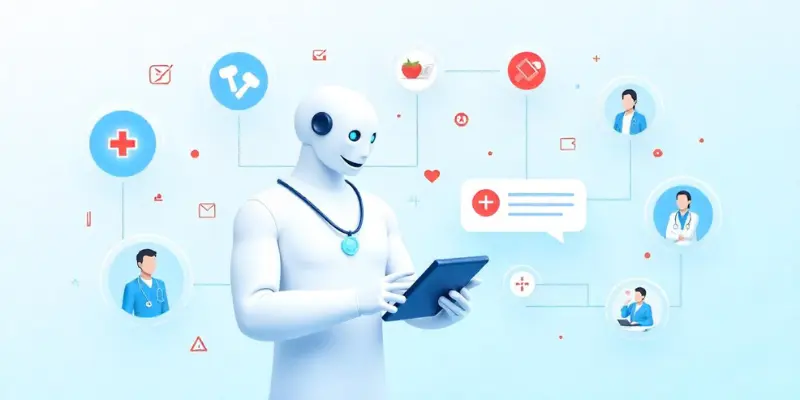Healthcare Conversational AI: A Revolution From Texts to Voice Chats
Published: 6 Mar 2025
Have you ever talked to a chatbot on a hospital website? Or asked a voice assistant about your symptoms? That’s called Conversational AI in healthcare.
It may sound like something from the future, but it’s already here and it’s helping people every day. Conversational AI means smart tools like chatbots, virtual assistants or voice assistants that can talk to people. In healthcare, they help patients, doctors, and hospitals talk to each other more easily and quickly.
Why is this important? Because many people want fast answers. Doctors want more time to focus on serious care. And hospitals want to help more patients without long waits.

What is Healthcare Conversational AI?
Imagine this: You walk into a clinic, but instead of waiting in line, you simply talk to a helpful assistant at the front desk. This assistant listens, answers your questions, books your appointment, and even reminds you to take your medicine later. Now imagine that this assistant isn’t a person but a smart computer program you can chat with anytime, even from home.
That’s what Healthcare Conversational AI is like. It’s a digital helper that talks to patients just like a human would. Healthcare Conversational AI is a smart computer tool that can understand and respond to people through text or voice. It uses AI to chat with users, answer health questions, help with tasks like scheduling, and even support doctors with routine work. It learns from conversations to get better over time.
For example, a person feeling unwell might type, “What are flu symptoms?” The AI chatbot responds with a list of common signs, saving the patient time. As these chatbots are trained by experienced medical staff on thousands of cases, thus they give accurate results.
Explore Different types of AI in healthcare.
How Does Healthcare Conversational AI Work?
Healthcare conversational AI works by using AI algorithms, such as Natural Language Processing techniques and machine learning models to understand and respond to patient questions. It processes words, finds the right answers and replies in a human-like way.
Here’s a simple breakdown of how it actually work:
- Understanding the Question – The AI reads or listens to what the patient says through natural language processing.
- Processing the Information – It analyzes the question and searches its database of relevant cases for the best response.
- Giving an Answer – It’s then replies with helpful information which may be a suggestion or a next step.
For example, if a patient types, “How do I lower a fever?” the AI bot might respond with:
➡ “You can drink plenty of fluids, rest and take fever-reducing medicine like acetaminophen. If symptoms get worse, you should have to see a doctor.”

Common Healthcare Conversational AI Tools
Healthcare conversational AI comes in different forms, each is made for performing a specific task. Some tools help with symptoms, while others focus on mental health, record keeping, scheduling or other administrative tasks. Here are the main types:
1. Symptom Checker Chatbots
These chatbots ask patients about their symptoms, process them and suggest the best possible solution. They don’t diagnose deeply but help users decide if they need to see a doctor. For example, Ada Health is a chatbot which helps the users to understand their symptoms and possible causes.
2. Virtual Health Assistants
They provide general medical advice, remind patients to take medicine and help in managing chronic conditions. These assistants reduce unnecessary hospital visits hereby reducing medical cost. For example, Google’s AI-powered health assistant supports patients with health queries.
3. Mental Health Tools
These tools are designed to offer emotional support. These AI tools help people dealing with stress, anxiety or depression, especially the elderly or disabled people. It interacts with them and keeps them engaged. For example, Woebot is an AI chatbot that helps users cope with mental health challenges.
4. Administrative Tools
These bots handle non-medical tasks like booking doctor appointments, sending reminders and managing patient records. These tools help the doctors to focus more on patients’ critical issues rather than repetitive tasks. For example, Hospital scheduling bots are the AI chatbots that help patients book visits quickly.
Each tool makes healthcare more efficient and accessible. Which one do you think benefits patients the most?
Also read a detailed article on Applications of AI in healthcare.
How AI Chatbots Are Transforming Patient Care
AI Chatbots are the simplest examples of Healthcare conversational AI which has already revolutionized the way patients receive personalized care and is becoming advanced with every coming day. It makes medical help faster, easier and more accessible. Here’s how AI chatbots are improving patient experiences:

1. Improving Patient Engagement
Patients no longer have to wait hours for answers from doctors to solve simple health issues. When you ask these chatbots about your medical condition, they provide instant responses even in seconds. In this way chatbots keep patients engaged and informed.
Example: A patient asks, “What are the side effects of ibuprofen?” The chatbot quickly provides a clear answer.
Also read AI companies in patient engagement and earn how these companies are improving patient care.
2. 24/7 Healthcare Support
Doctors are not always available, but their highly trained chatbots are. Patients can get medical guidance anytime anywhere, day or night which is not possible for a human being.
Example: A person with flu symptoms chats with an AI assistant at midnight and gets advice on home remedies.
3. Assisting Healthcare Professionals
AI chatbots reduce the workload of doctors and nurses by handling routine tasks like answering common questions. By handling repetitive tasks, these chatbots provide impulse time for the healthcare professionals to focus more on patient care.
Example: Instead of a receptionist handling calls and bookings, a chatbot schedules appointments automatically.
4. Mental Health & Emotional Support
AI chatbots provide a safe space for users to talk about stress and anxiety. They offer coping techniques, engage socially and provide support when no one else is available.
Example: Someone feeling anxious chats with Woebot and gets ideas of calming exercises.
5. Faster Appointment Booking & Medication Reminders
Chatbots help patients book doctor visits according to their schedule. They remind them to take their medicine on time just like their mom in the home.
Example: A patient types, “Remind me to take my blood pressure pill at 8 AM.” The chatbot sets up a reminder.
Real Uses in Hospitals and Clinics
Healthcare Conversational AI is already working behind the scenes in many places. Let’s look at how it helps patients, doctors and hospitals every day.
Helping Patients
Patients are the heart of healthcare. Conversational AI makes their experience easier and faster.
Here’s how:
- Book Appointments
No more waiting on hold. Patients can chat with a bot to pick a time that works for them. - Check Symptoms
Feeling sick? A virtual assistant can ask questions and suggest what to do next. It’s like a quick health quiz. - Get Medicine Reminders
Some AI tools send friendly reminders—so you don’t forget your pills or doctor visits.
Example: A busy mom opens a clinic’s app. She types, “Schedule vaccine for my son.” The chatbot replies in seconds and books it for next week.
Helping Doctors and Nurses
Doctors are busy. Conversational AI gives them more time for patients who really need care.
Here’s how it helps:
- Answers Common Questions
Instead of answering the same questions all day (“What are the side effects?”), AI handles them and act as a smart helper for the doctors.- Shares Test Results
Patients can ask the chatbot, “Are my blood test results ready?” and get a reply right away.- Organizes Tasks
AI can help doctors by sorting patient messages or even preparing notes for visits.- Example: A nurse uses a voice assistant to quickly check patient notes without leaving the room.
Helping Hospitals
Hospitals run smoother when simple jobs are handled by technology.
Here’s what AI can do:
- Reduce Phone Calls
Fewer calls mean faster service for everyone.- Shorten Waiting Times
Patients get help right away through chat, even before they walk in.- Keep Patients Happy
When answers come fast and help is friendly, people feel more cared for.Example: A small clinic adds a chatbot to its website. In one month, it answers over 300 patient questions without staff help.
Learn more about latest AI trends from recent healthcare conferences.
Challenges and Limitations of Healthcare Conversational AI Chatbots
AI chatbots are updating patient care in the best possible way, but they are not perfect. Here are some challenges they face:
| Healthcare Conversational AI Limitations |
|---|
1. Lack of Human Judgment Conversational AI can talk to patient about health advice but it cannot replace doctors. They follow predefined rules and machine learning models which means they might miss complex or rare conditions.
Here is an example: A chatbot may suggest home treatment for a headache, but it cannot detect if the headache is a symptom of a serious condition like a brain tumor. 2. Accuracy and Reliability Issues AI chatbots rely on data and if the data is incomplete or outdated, their responses might be incorrect. This can lead to misinterpretation of symptoms and wrong recommendations.
3. Privacy and Data Security Risks Healthcare conversational AI handle sensitive patient information which makes them an easy target for cyberattacks. If data is not properly secured, it could be misused.
4. Limited Emotional Understanding Conversational AI in healthcare can simulate empathy but they don’t truly understand human emotions. This makes them less effective in providing deep emotional support, especially for mental health cases.
5. Language and Communication Barriers Many AI chatbots, virtual assistants and voice assistants are trained in specific languages and medical terminologies which can be a problem for patients who speak different dialects or use informal phrases.
|
You may want to read healthcare AI problems.
The Future of Healthcare Conversational AI
AI technologies are evolving rapidly and their impact on healthcare will expand at a very fast pace in the coming years. As Healthcare AI is integrated in our lives, we can expect AI-driven conversations to become more intelligent, accurate and human-like. This will enhance patient care in multiple ways. Here are the key trends shaping the future of healthcare conversational AI:
1. More Advanced AI for Accurate Diagnoses
Conversational AI is expected to improve their diagnostic accuracy by leveraging vast amounts of healthcare data. Future AI models will integrate easily with electronic health records, genetic data and real-time patient inputs to assist with more accuracy.
- With continuous learning capabilities, AI will refine its decision-making by minimizing errors and reducing misdiagnoses.
- Additionally, AI chatbots will collaborate with medical professionals and provide second opinions based on pattern recognition in patient symptoms.
2. Voice-Enabled Healthcare Assistants
The next generation of voice assistants will incorporate better voice recognition technology. These AI assistants will use NLP and speech recognition to interpret patient inquiries and respond in a conversational, human-like manner. With voice interactions, coversational AI will become more intuitive, faster, quicker and easier to use, making healthcare more accessible to a broader audience.

3. Personalized AI-Powered Treatment Plans
Future conversational AI will not only provide general healthcare advice but will also offer fully personalized treatment plans based on individual patient data. These treatment plans will be customized according to medical history, lifestyle habits, genetic tendencies and ongoing treatments.
4. Integration with Wearable Devices
This conversational AI will integrate with more advanced smart watches, fitness trackers and other healthcare ai wearables to provide continuous health monitoring.
- These integrations will enable AI chatbots to track heart rate, blood pressure, glucose levels, physical activity and sleep patterns in real time.
- By analyzing this data, conversational AI will detect irregularities, send timely alerts and even recommend lifestyle adjustments.
- This connectivity will be particularly beneficial for patients with chronic conditions such as diabetes, heart disease and hypertension, as they will receive real-time health insights and early warning signals before symptoms worsen.
5. AI Chatbots Supporting Mental Health Therapy
Conversational AI will play a crucial role in mental health support and therapy by offering continuous emotional assistance to individuals facing anxiety, depression, stress and other psychological challenges.
- Future AI chatbots will be equipped with advanced sentiment analysis and emotions detection capabilities, allowing people to recognize soft hints in text and voice messages.
- By analyzing a patient’s tone, language and response patterns, AI chatbots will provide more compassionate and context-aware mental health guidance.
- These chatbots will complement traditional therapy by providing on-demand support, exercises and mental wellness programs to users in need.
Conclusion
Healthcare conversational AI is bringing ease in our lives by making medical support faster, smarter and more accessible. We discussed how these AI techs are helping patients with quick health advice, appointment scheduling medication reminders and mental health support. However, AI chatbots are not here to replace doctors. They are designed to assist medical professionals and empower patients with better healthcare solutions.
Now is the time to embrace innovation and explore how AI chatbots can improve healthcare experiences. Whether you are a healthcare provider or a patient, staying informed about healthcare conversational AI can open doors to a smarter and healthier future. Let’s move forward together and make healthcare more accurate, accessible and patient-friendly!
FAQs about Healthcare conversational AI
Here are some frequently asked questions about out written article, do not forget to ask a question in the comment if not addressed.
The cost varies widely depending on the complexity and features needed, typically ranging from $5,000 to $50,000+ for initial setup. Monthly subscription fees can range from $100 to $5,000+ based on usage volume and functionality. Many providers offer scalable pricing plans that grow with your patient base.
Most healthcare AI systems include disclaimers stating they provide information, not medical advice, and recommend consulting healthcare professionals for serious concerns. Healthcare providers typically have liability insurance and protocols in place to handle such situations. The AI is designed to escalate complex cases to human professionals rather than provide definitive diagnoses.
Yes, many modern healthcare AI systems support multiple languages, though accuracy may vary by language. The most advanced systems work well in major languages like English, Spanish, and Mandarin. Smaller or regional languages may have limited support, so it’s important to check language capabilities before implementation.
Initial setup and basic training typically takes 2-6 weeks, depending on the complexity of your medical specialty and existing data. The AI continues learning and improving over time through interactions with patients and feedback from medical staff. Full optimization for a specific practice can take 3-6 months of real-world usage.
Most cloud-based solutions require only a stable internet connection and modern web browser or mobile app. For on-premise solutions, you’ll need adequate server capacity and IT support for maintenance. Integration with existing electronic health records (EHR) systems may require additional technical setup and API connections.
Studies show mixed reactions, with younger patients generally more accepting of AI interactions. Many patients appreciate the 24/7 availability and immediate responses for simple questions. However, some prefer human interaction for complex or sensitive health matters, which is why successful implementations offer both options.
Most healthcare AI systems are programmed to recognize potential emergencies and immediately direct users to call emergency services or visit the nearest hospital. They cannot provide emergency medical treatment but serve as a first-line triage system. The AI is designed to err on the side of caution when detecting serious symptoms.
Staff typically need 4-8 hours of basic training to understand how the AI works, how to monitor its interactions, and when to intervene. Ongoing training focuses on reviewing AI conversations, updating knowledge bases, and improving response accuracy. Most systems provide user-friendly dashboards that don’t require technical expertise.
Most modern healthcare AI platforms offer API integrations with popular EHR systems like Epic, Cerner, and Allscripts. The integration allows the AI to access relevant patient information (with proper permissions) and update records automatically. Setup typically requires coordination between your IT team and the AI provider’s technical support.
Healthcare AI must comply with HIPAA (in the US), GDPR (in Europe), and other regional data protection laws. The AI systems must have proper security measures, audit trails, and patient consent mechanisms. Many reputable providers offer compliance-ready solutions, but healthcare organizations should verify regulatory requirements with legal counsel.





